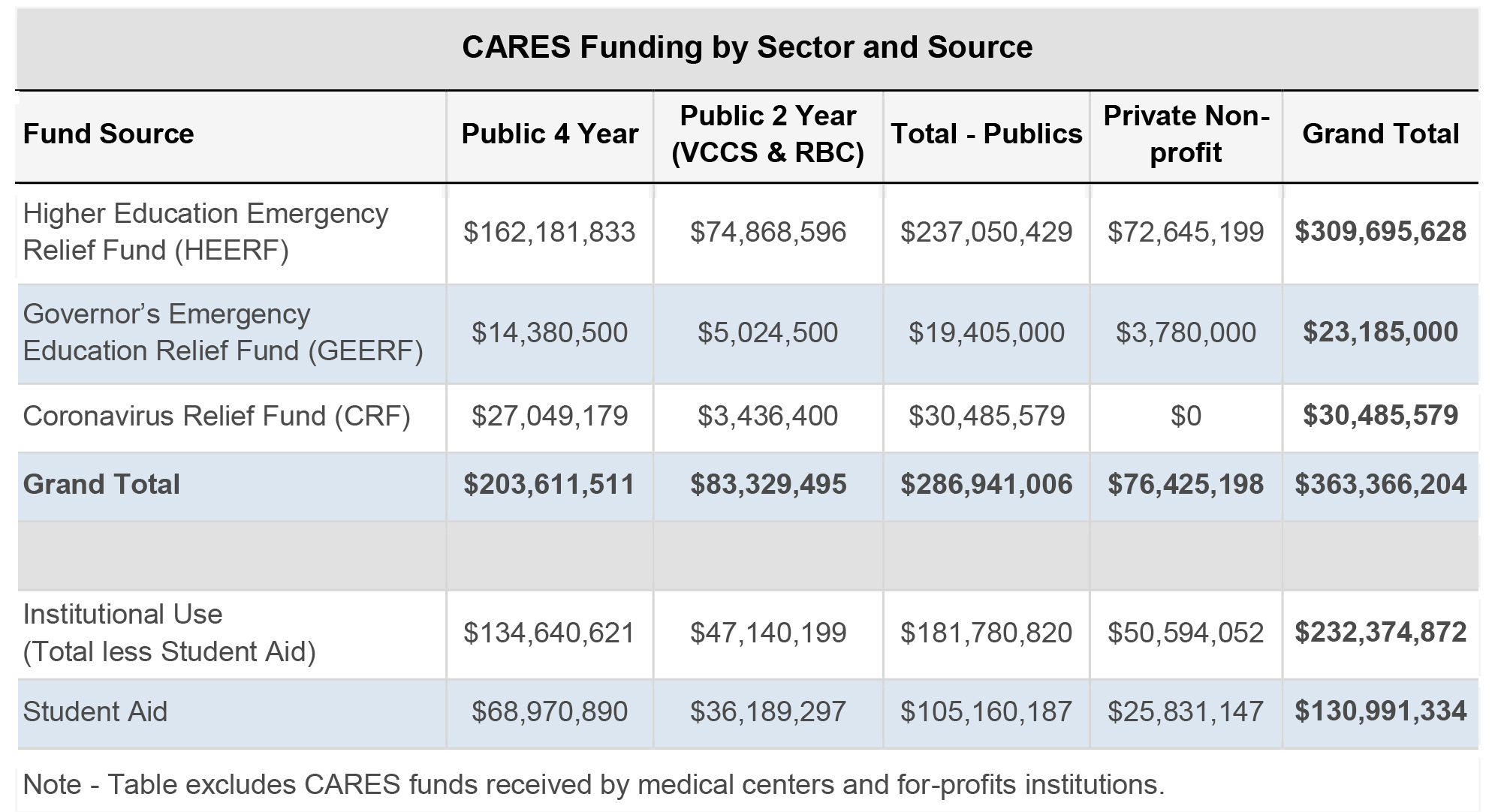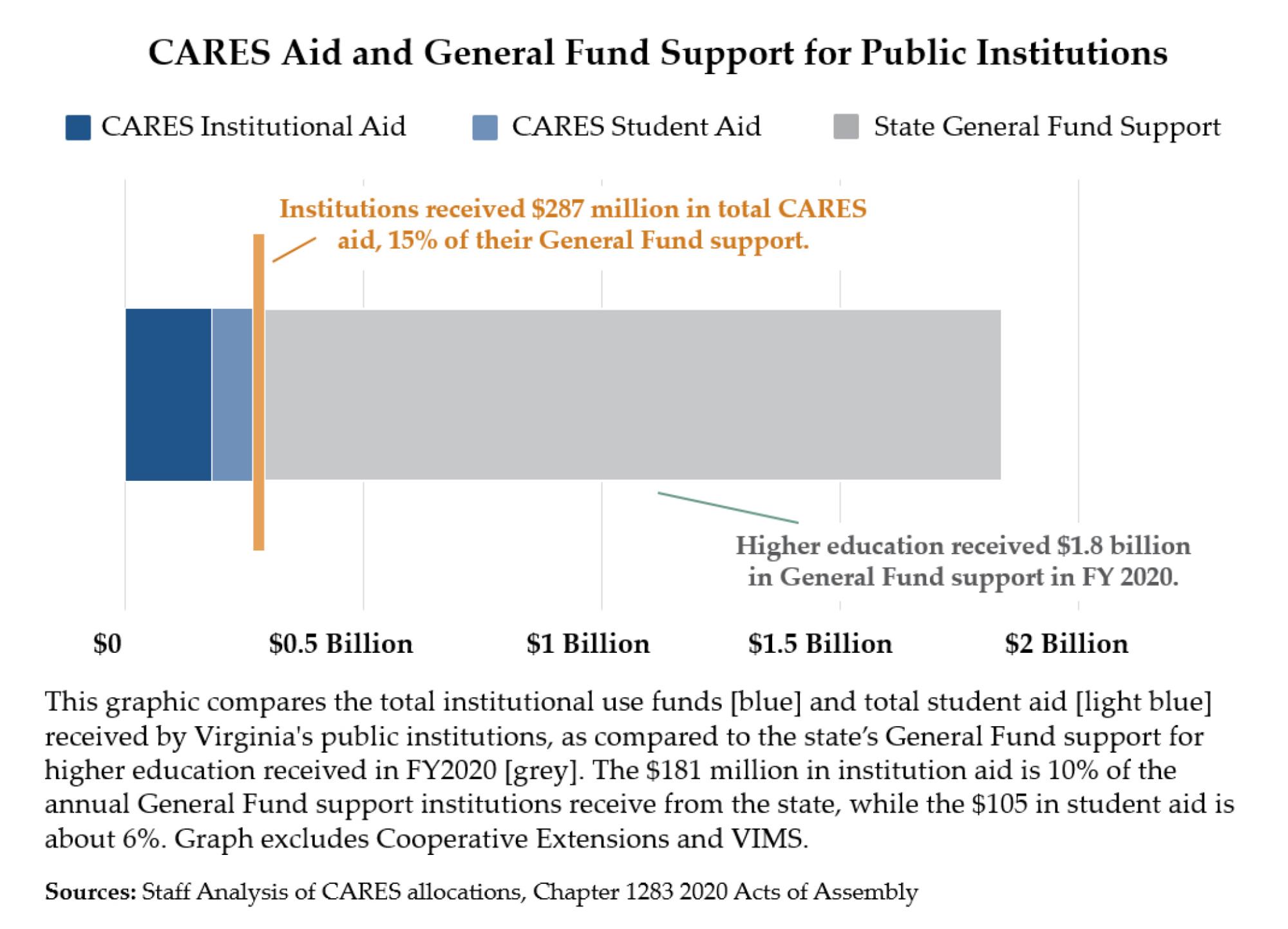Last March, the federal government passed the CARES Act to address the economic and public health crises caused by COVID-19. As part of that $2.5 trillion package, lawmakers included $14.2 billion dollars in direct aid to higher education institutions, as well as discretionary aid funds which institutions might be eligible for. After the dust settled, we now know Virginia’s public institutions and students were allocated a total of $287 million. Private institutions received another $76 million.

The majority of funds received by Virginia’s institutions came from the Higher Education Emergency Relief Fund (HEERF). The HEERF funds were divided into three different sections, with each section using a different allocation formula. The first section allocated the largest portion of HEERF (90% of the fund), and used a formula based on an institution’s total full-time in-person enrollment with a weight for the number of Pell-eligible students enrolled. However, lawmakers required at least 50% of this section’s allocation go directly to students as emergency aid. We’ve included totals with and without this student aid in Table 1, to show the total institutions received and the portion that went directly to students.
The second section of HEERF, which accounted for 7.5%, provided additional aid for institutions serving specific populations such as Historically Black Colleges and Universities (HBCUs). Finally, the remaining 2.5% of HEERF was reserved for the U.S. Secretary of Education to use at her discretion.
In addition to HEERF direct aid, some institutions received assistance from two discretionary CARES provisions: the Governor’s Emergency Education Relief Fund (GEERF), which provided flexible funds to governors to use for both pre-K-12 and higher education and the Coronavirus Relief Fund (CRF), which assists state agencies in covering costs related to COVID-19 response.

To put the aid received by public students and institutions into context, it might help to compare these federal funds with the state budget’s contributions. In FY 2020, Virginia allocated $1.8 billion in state support for public higher education. As the chart illustrates, that’s over ten times the amount of institutional aid and twenty times the amount of student aid received from the CARES Act. Combined, CARES represents 15% of the state’s general fund support for higher education.
Disruptions from COVID-19 triggered significant news for higher education, which the $287 million in CARES was designed to address. Who received the aid - students or institutions - largely determined how the funds got used:
- Students:
Congress required that approximately half of HEERF funds received by institutions ($105 million) go directly to students as emergency aid, which works out to an average of $368 per student. This aid was to help students “cover expenses related to the disruption of campus operations due to coronavirus,” such as food, housing, and technology costs. For context, Virginia students faced an average of $4,920 in unmet need going into the pandemic.
- Institutions:1
Public institutions received on average $635 per student, or 11% of state support per FTE, to tackle COVID-19 related disruptions. Institutions used their portion of CARES aid to address revenue losses from last spring semester such as refunds to students for housing and dining. They also used their funds to cover new expenses coming from the transition to online learning, research, and other costs. While each institution faces unique circumstances, many have exhausted their federal aid to cover these disruptions, and have no remaining funds to mitigate future COVID-19 impacts.
In summary the aid received by students and institutions was incredibly valuable. However, students still have to cover their unmet need from before the pandemic (which has likely grown due to the economic crisis it caused), and institutions are contending with substantial revenue losses for this fall from freezing or reducing tuition. Higher education is still facing challenges from COVID-19, and CARES can only do so much to address students’ and institutions’ needs.
It’s unclear if higher ed will get any more emergency aid from Congress. What is clear is that in the absence of controlling the pandemic, and the subsequent economic recovery that would follow, student and institutional needs will persist. Understanding how CARES impacted our students and institutions is critical in addressing the challenges facing higher education in the Commonwealth, and further equity and the goals our state has for higher education.
1One expense institutions used their CARES funds in particular for was technology for students. This includes devices, and also expanding broadband and internet access. We discussed the digital divide students face in our last Insight; some 62,000 students are without broadband while another 23,000 lack access to a computer. Much of this aid will disappear in January or when the CARES funds are expended by institutions.
CARES Insights TABLES (xls)
Welcome to Insights, SCHEV's platform to interpret and communicate data and policy with the overall goal of informing policy-making, engaging institutions and drawing attention to these resources. Centered around SCHEV's nationally leading data collection, each Insight will visualize complex ideas and help inform funding and policy decisions.





